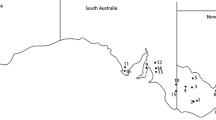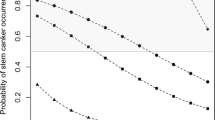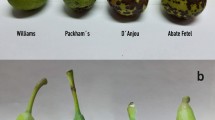Abstract
New disease symptoms were observed on canola (Brassica napus) crops late in the 2019 and 2020 growing seasons in Western Australia. Cladosporium macrocarpum was isolated from infected material, and the fungus responsible for the symptoms was demonstrated by fulfilling Koch’s postulates. One strain exhibited relatively high tolerance to prothioconazole and tebuconazole fungicides compared to other canola pathogens Sclerotinia sclerotiorum and Leptosphaeria maculans. In a 2019 field trial in a commercial canola crop, symptom incidence caused by Cladosporium was only significantly reduced by a double application of a foliar fungicide (active ingredients prothioconazole and tebuconazole) registered in canola for other diseases, while single applications gave no significant response. This new disease, caused by a ubiquitous fungal species, may be a consequence of changes to farm management strategies to reduce other fungal diseases of canola.






Similar content being viewed by others
References
Al-Lami HFD, You MP, Barbetti MJ (2019) Incidence, pathogenicity and diversity of Alternaria spp. associated with alternaria leaf spot of canola (Brassica napus) in Australia. Plant Pathol 68:492–503
Bensch K, Braun U, Groenewald JZ, Crous PW (2012) The genus Cladosporium. Stud Mycol 72:1–401
Bensch K, Groenewald JZ, Braun U, Dijksterhuis J, de Jesús Yáñez-Morales M, Crous PW (2015) Common but different: the expanding realm of Cladosporium. Stud Mycol 82:23–74
Clear RM, Patrick SK (1995) Frequency and distribution of seedborne fungi infecting canola seed from Ontario and western Canada - 1989 to 1993. Can Plant Dis Survey 75:9–17
Corlett M (1988) Taxonomic studies in the genus Mycosphaerella. Some species of Mycosphaerella on Brassicaceae in Canada. Mycotaxon 31:59–78
Dalili A, Bakhtiari S, Barari H, Aldaghi M (2015) Effect of some fungicides against the growth inhibition of Sclerotinia sclerotiorum mycelial compatibility groups. J Plant Prot Res 55:354–361
David JC (1997) A contribution to the systematics of Cladosporium: revision of the fungi previously referred to Heterosporium. Mycol Pap 172:1–157
Derbyshire MC, Denton-Giles M (2016) The control of sclerotinia stem rot on oilseed rape (Brassica napus): current practices and future opportunities. Plant Pathol 65:859–877
Eckert MR, Rossall S, Selley A, Fitt BDL (2010) Effects of fungicides on in vitro spore germination and mycelial growth of the phytopathogens Leptosphaeria maculans and L. biglobosa (phoma stem canker of oilseed rape). Pest Manag Sci 66:396–405
Kearse M, Moir R, Wilson A, Stones-Havas S, Cheung M, Sturrock S, Buxton S, Cooper A, Markowitz S, Duran C, Thierer T, Ashton B, Meintjes P, Drummond A (2012) Geneious Basic: an integrated and extendable desktop software platform for the organization and analysis of sequence data. Bioinformatics 28:1647–1649
Kumar S, Stecher G, Tamura K (2016) MEGA7: Molecular Evolutionary Genetics Analysis version 7.0 for bigger datasets. Mol Biol Evol 33:1870–1874
Persoon CH (1801) Synopsis Methodica Fungorum
Pitkin JW, Panaccione DG, Walton JD (1996) A putative cyclic peptide efflux pump encoded by the TOXA gene of the plant-pathogenic fungus Cochliobolus carbonum. Microbiology 142:1557–1565
Schoch CL, Seifert KA, Huhndorf S, Robert V, Spouge JL, Levesque CA, Chen W, Fungal Barcoding Consortium (2012) Nuclear ribosomal internal transcribed spacer (ITS) region as a universal DNA barcode marker for Fungi. Proc Natl Acad Sci USA 109:6241–6216
Schubert K, Groenewald JZ, Braun U, Dijksterhuis J, Starink M, Hill CF, Zalar P, de Hoog GS, Crous PW (2007) Biodiversity in the Cladosporium herbarum complex (Davidiellaceae, Capnodiales), with standardisation of methods for Cladosporium taxonomy and diagnostics. Stud Mycol 58:105–156
Sprague SJ, Marcroft SJ, Lindbeck KD, Ware AH, Khangura RK, Van de Wouw AP (2017) Detection, prevalence and severity of upper canopy infection on mature Brassica napus plants caused by Leptosphaeria maculans in Australia. Crop Pasture Sci 69:65–78
Van de Wouw AP, Idnurm A, Davidson JA, Sprague SJ, Khangura RK, Ware AH, Lindbeck KD, Marcroft SJ (2016a) Fungal diseases of canola in Australia: identification of trends, threats and potential therapies. Australas Plant Path 45:415–423
Van de Wouw AP, Marcroft SJ, Howlett BJ (2016b) Blackleg disease of canola in Australia. Crop Pasture Sci 67:273–283
Van de Wouw AP, Marcroft SJ, Sprague SJ, Scanlan JL, Vesk PA, Idnurm A (2021) Epidemiology and management of blackleg of canola in response to changing farming practices in Australia. Australas Plant Pathol 50:137–149
White TJ, Bruns T, Lee S, Taylor J (1990) Amplification and direct sequencing of fungal ribosomal RNA genes for phylogenetics. PCR Protocols: a guide to methods and applications. Academic Press, Inc. 315–322
Yang Y, Marcroft SJ, Forsyth LM, Zhao J, Li Z, Van de Wouw AP, Idnurm A (2020) Sterol demethylation inhibitor fungicide resistance in Leptosphaeria maculans is caused by modifications in the regulatory region of ERG11. Plant Dis 104:1280–1290
Acknowledgements
This research was supported by the University of Melbourne, Australian Research Council (ARC grant LP170100548), Department of Primary Industries and Regional Development (DPIRD) and the Grains Research and Development Corporation (GRDC and DPIRD co-funded projects DAW1907-002RTX and DAW1810-007RTX). We thank Jacky Edwards (Agriculture Victoria) and Vincent Lanoiselet (DPIRD) for advice on disease reporting procedures and C. macrocarpum incidence in Australia, and for accessioning strains and diseased material. We also thank the growers who hosted the field trials, Bayer for providing the fungicide used in the trials and Syngenta for providing fungicides for in vitro, David Nicholson and Debra Donovan (DPIRD) for their assistance in season at Dale, and DPIRD research support units at Geraldton and Northam who harvested the Alma and Dale trials, respectively.
Author information
Authors and Affiliations
Corresponding author
Ethics declarations
Conflict of interest statement
Through ARC linkage project LP170100548 A.I. receives funding for research from Syngenta Australia. Any use of registered trade names is for the purpose of research transparency, and constitutes neither an endorsement nor a recommendation against products or services by the authors, their institutions, or their funding bodies.
Rights and permissions
About this article
Cite this article
Idnurm, A., Beard, C., Smith, A. et al. Emergence of Cladosporium macrocarpum disease in canola (Brassica napus). Australasian Plant Pathol. 50, 687–694 (2021). https://doi.org/10.1007/s13313-021-00819-8
Received:
Accepted:
Published:
Issue Date:
DOI: https://doi.org/10.1007/s13313-021-00819-8




